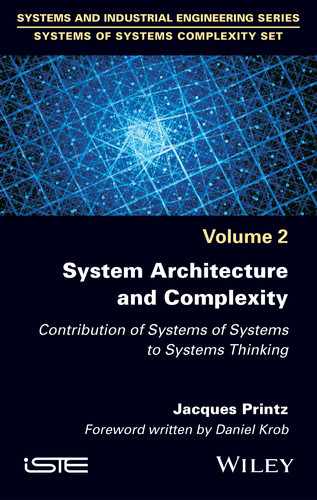List of Acronyms
- AC/TC:
- Algorithmic Complexity/Textual Complexity
- AF:
- Architecture Framework, found in many acronyms such as TOGAF (The Open Group Architecture Framework)
- AU:
- Active Unit; the indivisible core of a project team composed of 5–10 people
- BPML/BPMN:
- Business Process Modeling Language/Notation
- C/CCAM:
- Cybernetics or Control and Communication in the Animal and the Machine (founding work by N. Wiener)
- C2/C3/C4ISR/C4ISTAR:
- Acronyms used to represent the group of military functions designated by C4 (Command, Control, Communications, Computers), I (Military Intelligence) and STAR (Surveillance, Target Acquisition and Reconnaissance) and intended to allow coordination of operations
- CCITT:
- Consultative Committee for International Telephony and Telegraphy, until 1993. It deals with technical subjects and standardization, and has been replaced by the ITU-T
- CERN:
- European Organization for Nuclear Research
- CMMI:
- Capability Maturity Model Integration, reference model. A structured set of good engineering practices, from the work of W. Humphrey at the Software Engineering Institute created by the US/DoD
- CMS:
- Centralized Management System
- COP:
- Common Operational Picture, NATO terminology; virtual maps shared by C4ISTAR operators
- COQ/CONQ:
- Cost of Quality/Cost of Non-Quality
- CQFD:
- Cost, quality, reliability, lead time
- CRUD/CRUDE:
- Create, Retrieve, Update, Delete; the basic operations carried out by all data models (Data Retrieval), with E for Execute
- DNA/ATCG:
- Deoxyribonucleic acid and its four chemical bases
- ECC:
- Error Correction Code
- EHV:
- Extra High Voltage lines in the electricity grid, from 400 to 700,000 volts
- ERA:
- Entity Relationship Attribute, data modeling language
- ESB:
- Enterprise Service Bus, middleware for interconnection of all the IS in a company
- FELIN:
- French integrated infantryman equipment and communications; individual combat system for French infantrymen, developed by the French land army
- FFRDC:
- Federally Funded Research and Development Centers; network of research agencies directed by the US government
- FURPSE:
- Functionality, Usability, Reliability, Performance, Serviceability, Evolutivity; ISO/IEC terminology
- GAFA/GAFAM:
- Acronym grouping together the large Internet companies in the USA: Google, Apple, Facebook, Amazon, Microsoft
- GPS:
- Global Positioning System, constellation of satellites put in place by the US army
- HFT:
- High-Frequency Trading, of the order of a millisecond, developed by the finance and banking sector
- IDEF:
- Integration Definition; modeling language standardized by the US DoD
- IEEE:
- Institute of Electrical and Electronics Engineers; with more than 400,000 members
- INCOSE:
- International Council on Systems Engineering
- INES:
- International Nuclear Event Scale, international classification scale of nuclear events; this includes seven risk levels
- IoT:
- The Internet of Things
- IPC:
- Inter Process Communication, layer of interfaces on which languages such as BPML are built
- IS/ICS/OIS:
- Information System/Information and Communication System/Operational Information System (in the field of defense and security)
- ITER:
- International Thermonuclear Experimental Reactor
- ITU:
- International Telecommunications Union; UN level
- LHC:
- Large Hadron Collider; machine at the CERN where Higgs boson was first proven to exist and measured.
- MEP:
- Maximum Entropy Production
- MERISE:
- Method for evaluation and modeling by sub-sets used in business computing or for company systems; analysis method, of design and constitution of information systems, very widely used in France in the 1980s
- MIB:
- Management Information Base
- MIPS/MFLOPS:
- Millions of Instructions Per Second; FLOP for scientific instructions known as “floating-point operations”; characterizes the calculation power
- MMI:
- Man–machine interface
- MTTF/MTTR:
- Mean Time To Failure/Mean Time To Repair
- NBIC/ICTS/ICT:
- Nanotechnology, Biology, Information Technology, Cognitive science/Information and Communication Technologies and Sciences/Information and Communication Technologies
- NCS:
- Network Centric Systems, systems whose architectural core is the network
- NTDS:
- Navy Tactical Data System; first naval system for the US Navy
- PAC:
- Probably Approximately Correct (title of the book by L. Valiant)
- PESTEL:
- Political, Economic, Social, Technological, Ecological, Legal
- PSTN:
- Public Switched Telephone Network
- QI:
- Quantity of Information, using Shannon’s formula
- RAS:
- Reliability, Availability, Serviceability
- SADT/SART:
- Structured Analysis and Design Techniques (Real Time); basis of the IDEF language
- SAGE:
- Semi-Automatic Ground Environment; ancestor of all air traffic control systems
- SCADA:
- Supervisory Control And Data Acquisition/Data control and acquisition system; all C4ISTAR systems have an SCADA for their periphery
- SCCOA:
- French surveillance and command system for aerial operations
- SENIT:
- French naval tactical information exploitation system; derived from the US NTDS
- SLA:
- Service-Level Agreement; service contract
- SoS:
- System of Systems
- STRIDA:
- French system for processing and representing aerial defense information; derived from the SAGE system
- SysML:
- Systems Modeling Language; extension based on UML
- TCO:
- Total Cost of Ownership; in project management
- TOGAF:
- Architecture frame advocated by the Open Group
- TPS:
- Transactions Per Second; measures the flow rate of a system, in the number of interactions per second
- UML:
- Unified Modeling Language; advocated by the Object Management Group
- U, S, E:
- User, System, Engineering; Simondon’s triplet
- VHDL:
- Very High Description Language, for description of VLSI, inspired by Ada, including parallelism
- VLSI/LSI:
- Very Large Scale Integration, from the 1990s onwards when the number of transistors per chip entered the tens of millions
- XML/SGML:
- Extended Markup Language, successor of Standard Generalized Markup Language, which appeared along with the Internet and the World Wide Web
..................Content has been hidden....................
You can't read the all page of ebook, please click here login for view all page.
